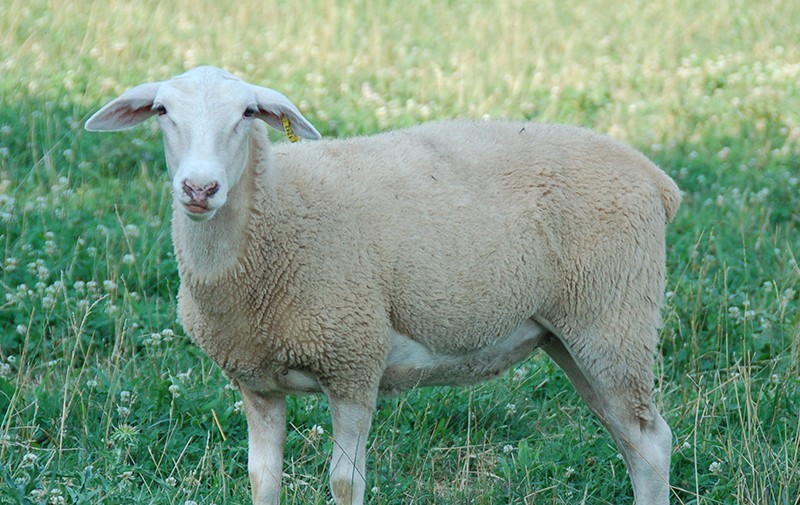
Origin
Though you may not be familiar with Lacaune sheep, it’s a good bet that you’ve heard of the most famous product made with their milk: Roquefort, the pedigreed French blue cheese that has been seducing turophiles since the time of the ancient Romans. Pliny the Elder, Julius Caesar, and Emperor Charlemagne are among a few of the most famous historical devotees of Roquefort’s rich, striking flavor. In 1411 King Charles VI gave rights to the aging of Roquefort to only one village: Roquefort-sur-Soulzon, a small town in south-central France about 100 miles west of Avignon, Provence.
History
Neolithic shepherds driving their flocks up from the plains of the Mediterranean coast brought the early ancestors of the Lacaune to the region 4,000 to 6,000 years ago. Though the upland meadows of the Causse country were rough and desolate and wracked by fierce winds, the land proved to be good sheep country, and the wandering shepherds decided they had finally found a good place to settle.
By the mid-19th century, local farmers were beginning to experiment with crossbreeding these Lacaune predecessors with other local breeds from Larzac, Camarès, the Causses, and Rodez. The resulting animals not only were ideally suited to the rugged territory but produced rich, flavorful milk and mild, beautifully colored meat. In the modern era Lacaune have been further selected for increased milk production under a sophisticated program incorporating artificial insemination, milk recording, and progeny testing of sires. Because of this rigorous process, today’s Lacaune sheep is the result of more studied genetic selection than any other dairy sheep breed in the world.
The first Lacaunes in North America were born on the farm of Joseph Regli in Ontario, Canada, just 15 years ago. Today Lacaunes and crosses of the breed are among the most popular sheep found in U.S. dairy flocks. Many farmers are currently experimenting with mixing the Lacaune, various domestic American breeds, and heavier, imported sheep such as Dorsets and Katahdins.
Appearance & Temperament
In 1902 the French government issued a ministerial decree officially defining the characteristics of the Lacaune breed: They are hornless, hardy, and able to resist dramatic temperature swings, thanks to their fine coat of white fleece; and their average weight is between 154 and 220 pounds. Lacaune ewes give perfumed, full-fat milk at the rate of around 74 gallons per season.
Given the breed’s storied history of natural and artificial selection, it should come as no surprise that the Lacaune is well adapted to the harsh conditions, rocky terrain, and extreme seasonal variations in temperature common to its home range. With small hooves made for navigating the stony ground and a short, double coat of white wool (the undercoat sheds out in the summer months), the Lacaune possesses all the necessary tools to thrive in its austere pasturage. It is an excellent grazer and can adapt to a variety of range conditions, but it is also ideally suited to modern dairy operations, thanks to years of selection for good udder health and disease resistance.
Despite its utilitarian attributes, the Lacaune is an elegant-looking creature with a proud demeanor. Its elongated head, arched profile, and slightly rounded snout imparts a dignified appearance, while its lack of horns and pendulous, floppy ears add a quality of playfulness.
Compared to other breeds, says Brenda Jensen, a Lacaune breeder and cheesemaker at Hidden Springs Creamery in Wisconsin, “Lacaunes are sassier. The East Friesians, for example, are very docile—they just toe the line… walk right into the milk parlor and are very calm and orderly. The Lacaunes, on the other hand, have this ‘I just don’t have to; I’m going to do what I want’ attitude. They add a little excitement to the parlor.”
Milk & Cheeses
Lacaunes are considered one of the best-performing breeds of dairy sheep, second only to the East Friesian. Their milk is usually described as pure and wholesome with high butterfat and protein content and excellent milk flavor. It is well suited to making a wide array of cheeses.
Though Roquefort is by far the most popular cheese made from the milk of Lacaune ewes, American cheesemakers with Lacaune and Lacaune-cross herds are currently experimenting with making a wide variety of cheeses, from raw milk, washed-rind types to delicately crumbly blues, semisofts, semihards, fetas, and many more. Jensen claims that the milk from her Lacaune sheep is the perfect milk for making cheese because of the high protein and butterfat content. “We knew when we got them that we definitely wanted to make a local blue that had that Lacaune influence. But really… it’s perfect for making just about any variety.





2 thoughts on “Lacaune Sheep”